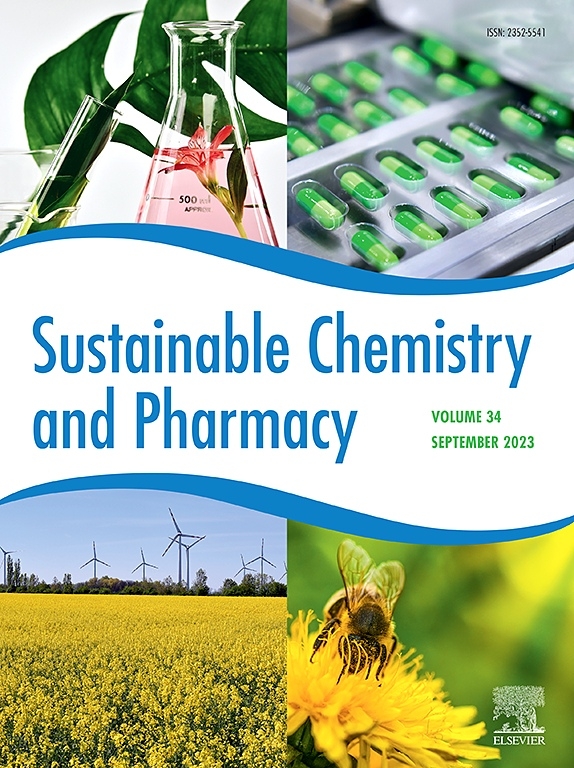Exploring the potential of mealworm chitosan for hemodialysis applications
IF 5.5
2区 化学
Q2 CHEMISTRY, MULTIDISCIPLINARY
引用次数: 0
Abstract
This study introduces a sustainable and efficient alternative to traditional chitosan sources derived from crustaceans, exploring the extraction and application of insect-derived chitosan from Tenebrio molitor for hemodialysis (HD) membranes design.
Efficient extraction and deacetylation methods were tested and developed between 6 h and 12 h to obtain chitosan. Chitin was isolated from T. molitor through deproteinization and demineralization, with yields of approximately 5 % (w/w). Chitosan was obtained from the extracted chitin resulting in yields of between 65.0 and 79.3 (w/w). Characterization using FTIR confirmed structural similarities with commercial chitosan and degrees of deacetylation in the 73–75 % range. The bioactive properties of chitosan obtained from T. molitor, including antimicrobial and antioxidant activities, were evaluated. All the microorganisms tested were inhibited, exhibiting minimum lethal concentrations between 2 and 8 mg/mL. In addition, chitosan showed antioxidant activity in the range of 60–65 μmol Trolox equivalent/g, suggesting its viability for various medical applications. This study additionally allowed the design of sustainable hybrid chitosan membrane (CH-M) tailored for HD applications. The permeation characteristics of CH-M for urea and albumin were studied in vitro to assess their suitability as HD membranes. Urea was permeable to values of over 70 % and albumin was retained. Also, cytotoxicity assays against L929 fibroblast cells demonstrated that the CH-M samples exhibit low metabolic inhibition (around 15 %) The application of CH-M in HD represents a significant advance, offering the potential for enhanced therapeutic outcomes for chronic kidney disease (CKD).

探讨粉虫壳聚糖在血液透析中的应用潜力
本研究介绍了一种可持续、高效的壳聚糖替代传统的甲壳类壳聚糖来源,探索从黄粉虫中提取壳聚糖并应用于血液透析(HD)膜的设计。在6 ~ 12 h的时间内,对壳聚糖的高效提取和脱乙酰化方法进行了试验和开发。通过脱蛋白和脱矿分离得到几丁质,收率约为5% (w/w)。壳聚糖的收率为65.0 ~ 79.3 (w/w)。FTIR表征证实其结构与商品壳聚糖相似,脱乙酰度在73 - 75%范围内。对壳聚糖的生物活性进行了评价,包括抗菌和抗氧化活性。所有测试的微生物都被抑制,最小致死浓度在2至8 mg/mL之间。此外,壳聚糖的抗氧化活性在60 ~ 65 μmol Trolox当量/g范围内,表明其具有广泛的医学应用价值。本研究还允许设计适合HD应用的可持续混合壳聚糖膜(CH-M)。研究了CH-M对尿素和白蛋白的体外渗透特性,以评价其作为HD膜的适用性。尿素的渗透性超过70%,白蛋白被保留。此外,对L929成纤维细胞的细胞毒性试验表明,CH-M样品表现出低代谢抑制(约15%)。CH-M在HD中的应用代表了一个重大进步,为慢性肾脏疾病(CKD)的治疗效果提供了潜在的增强。
本文章由计算机程序翻译,如有差异,请以英文原文为准。
求助全文
约1分钟内获得全文
求助全文
来源期刊

Sustainable Chemistry and Pharmacy
Environmental Science-Pollution
CiteScore
8.20
自引率
6.70%
发文量
274
审稿时长
37 days
期刊介绍:
Sustainable Chemistry and Pharmacy publishes research that is related to chemistry, pharmacy and sustainability science in a forward oriented manner. It provides a unique forum for the publication of innovative research on the intersection and overlap of chemistry and pharmacy on the one hand and sustainability on the other hand. This includes contributions related to increasing sustainability of chemistry and pharmaceutical science and industries itself as well as their products in relation to the contribution of these to sustainability itself. As an interdisciplinary and transdisciplinary journal it addresses all sustainability related issues along the life cycle of chemical and pharmaceutical products form resource related topics until the end of life of products. This includes not only natural science based approaches and issues but also from humanities, social science and economics as far as they are dealing with sustainability related to chemistry and pharmacy. Sustainable Chemistry and Pharmacy aims at bridging between disciplines as well as developing and developed countries.
 求助内容:
求助内容: 应助结果提醒方式:
应助结果提醒方式:


